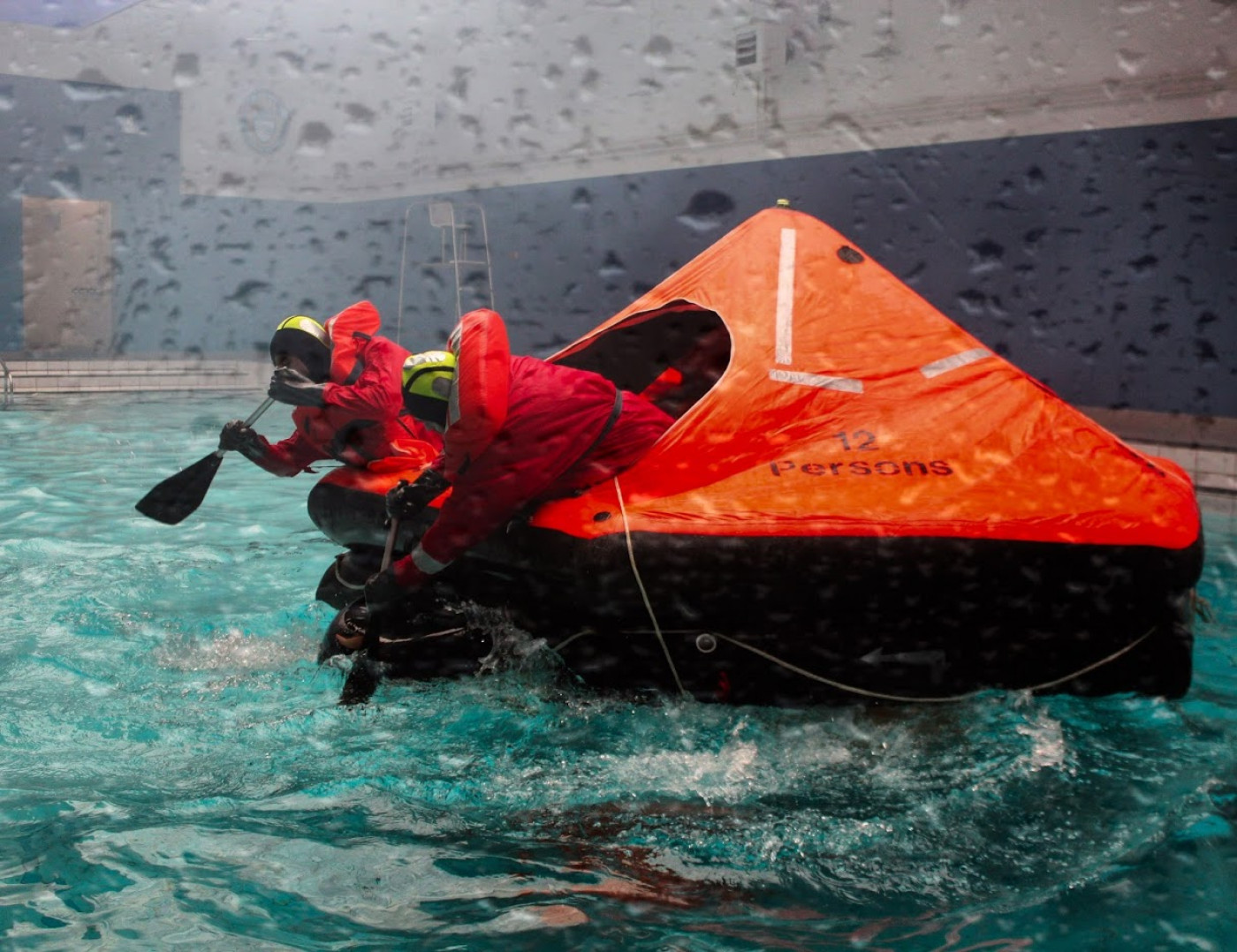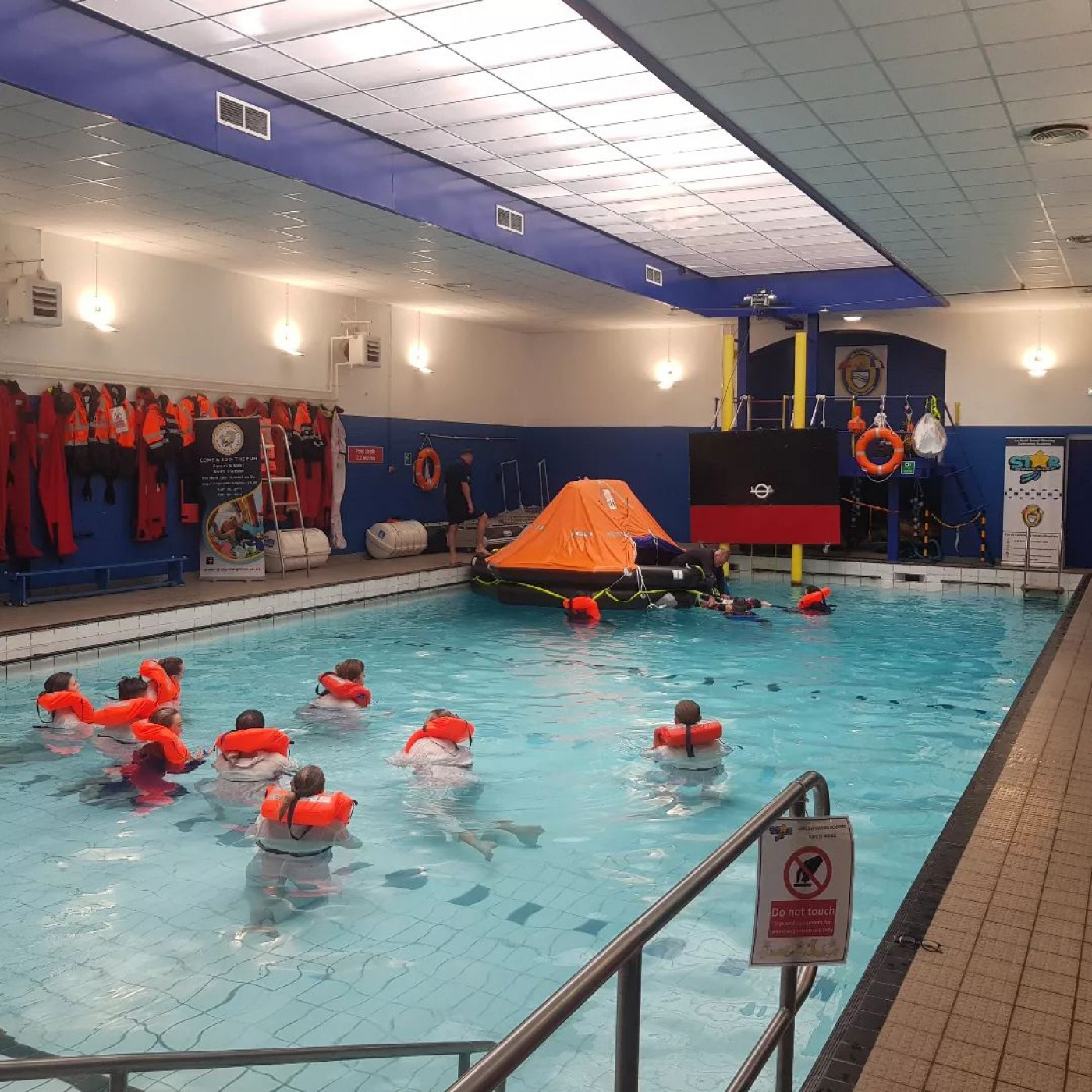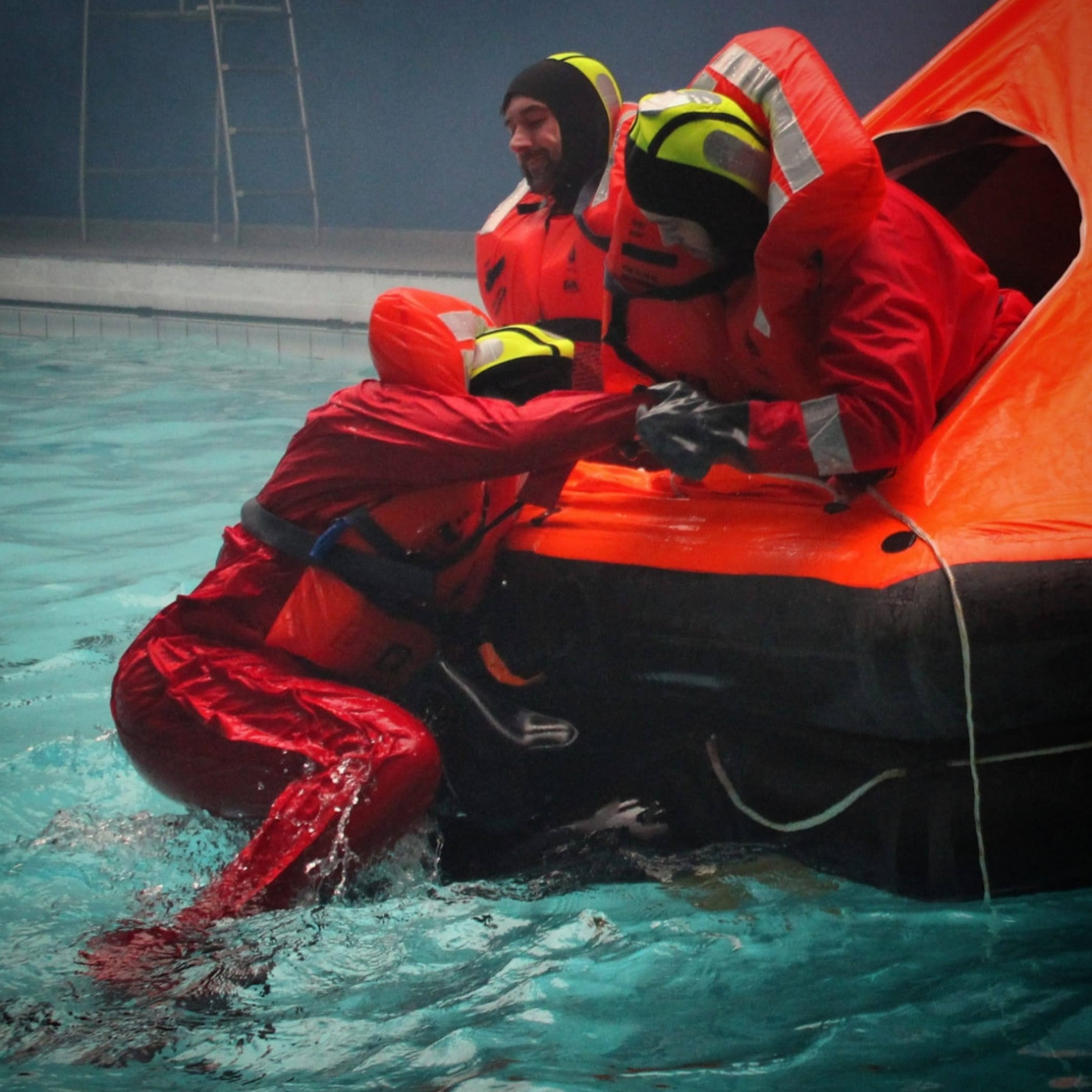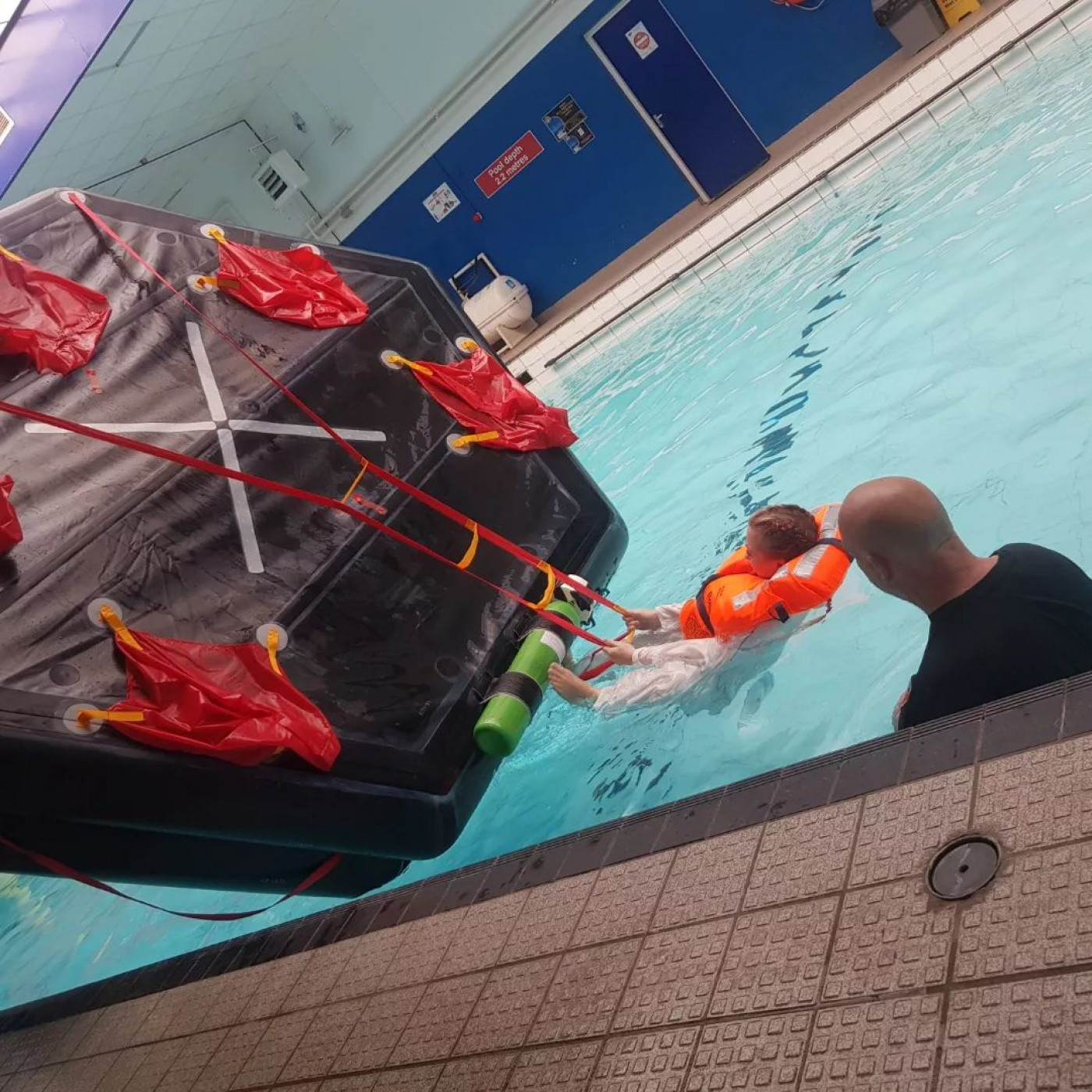Humans have always battled the danger of the ocean, and the effort to stay alive requires all hands on deck. Some of this effort comes in the form of four mandatory safety courses, required for anyone who wants to fish commercially. These came into being after the 1978 International Convention on Standards of Training, Certification and Watchkeeping for Seafarers, and they comprise basic sea survival, basic fire-fighting and prevention, basic first aid and basic health and safety. If I wanted to go to sea on a trawler, I at least needed to know basic sea survival. I found a course in Liverpool, a couple of hours away from my home in Yorkshire, and it was affordable and available.
The course was in Fazakerley, a Liverpool district that must have been named by Charles Dickens. A huge sign proclaimed that Seascope Maritime Training is based in Liverpool and Antibes, a geographic combination I’ve never before encountered. Inside, I checked in and looked around me: there were big lads, one with a tattoo on his face. There were young women in firefighting gear. There was a full-size enclosed lifeboat in the courtyard. It was busy and a little intimidating in the way that entirely novel experiences amongst strangers are.
In my intake, we included a young woman who was going to work on a superyacht, a Royal Naval reserve, a fisheries observer and an actual fisherman. After a short induction video, we headed for the pool, which was on the other side of the courtyard. There, we put on white boiler suits, so that we looked like a troupe of lost fishmongers, and a PFD (personal flotation device), the superior kind that have crotch straps so the PFD does not rise up to your chin when you are floating. The instructor was a stern man named Frank.
Into the water. Hold your hand over your mouth and nose and hold that hand with your other hand. Never jump in. Look below then step in.
I stepped in. It was warm. Frank said, “we keep the water this temperature because otherwise you wouldn’t retain any information, you’d be concentrating on the cold”. Cold water is more realistic but there’s no point training if you can’t concentrate for shivering. Shivering is the sign that hypothermia is coming; once you are hypothermic, you don’t shiver. The survivors who are still are the ones to worry about.
When you get in the water, float on your back and hold your knees.
In 2019, the Brixham fisherman Reegan Greene was washed overboard from the Emilia Jayne. He spent over an hour in freezing water and winds of 60 knots, before he was rescued by a Coastguard helicopter. In the helicopter’s video of the rescue, a grainy black and white figure can be seen in the sea. He is on his back as he should be. He is wearing a PFD as he should be.
We did a circuit of the pool, swimming backwards as you should if thrown overboard, and as Reegan did.
Get your arms really underwater, like a backwards butterfly, cup your hands so you really shift water. No arm doggy paddling.

Seascope Sea Survival Course

Seascope Sea Survival Course
Then: the huddle.
If there is a group of you and you cannot get to a life-raft, form a circle, arm in arm. In the middle the water will be slightly warmer and if there is an injured person, put them here.
I linked my arms with strangers who were quickly getting to be less strange. The only other activity I’ve been this intimate with strangers is while scuba diving. Awkwardness dissolves in an overheated swimming pool. We floated together while Frank told us about the USS Indianapolis, a wartime sinking, and about how many men were eaten by sharks. 900 men went into the water; only 316 survived. Throughout the day various disasters are invoked to teach a lesson. Costa Concordia and Titanic are the most frequent. (Most Titanic passengers who reached the water did not drown, but died of hypothermia.) The story of a helicopter rescue teaches us about circumrescue collapse and hydrostatic squeeze, when living survivors can suddenly die when removed from the water, because their blood pressure drops precipitously, and the heart fails.
It was time for the tows. First, in pairs, we towed a partner. Then there was a group tow, two teams competing. Ours descended into chaos, with frantic splashing and confusion. Throughout the pool session, we were told again and again, “don’t panic.” But we were not told how not to panic, although the skill of not panicking is probably the most important for survival.
For the abandon ship drill, we were assigned tasks and told how to behave when the drill began, then sent to wait in the changing rooms. There we stood around awkwardly, jokes were cracked to break the wait, then smoke started to pour in. The alarm went — 7 short blasts and one long — and we headed to the pool, now transformed: now it was dark and cold and there was smoke everywhere and suddenly everyone forgot everything and they jumped in like idiots before hauling themselves into the liferaft. “NOT LIKE THAT” bellowed Frank. My job was to catch the quoit that the fisheries observer Alastair would throw from the lifeboat. I jumped in last, and waited for the quoit ring. Only Alastair got to the boat, then instead of throwing the ring and holding onto its rope, he threw the whole lot in, then jumped in after it. Frank is furious.
Once you’re in a life-raft you never get back in the water. NEVER GET BACK IN THE WATER.
I fetched the quoit, remembered to put it around my arm, and was towed to the liferaft. Only they forgot to tell me to cross my arms and go sideways, so I arrived with a mouth and face full of chlorine spray. But I am definitely higher up the teacher’s-pet ladder than Alastair, and amongst the chaos and panic, as we frantically paddled the liferaft to the far side of the pool, I was quietly smug.
NEVER GET BACK IN THE WATER

Seascope Sea Survival Course

Seascope Sea Survival Course
In the government’s Fisherman’s Safety Guide, an early section is entitled “What can go wrong.” The answer is “hazard.” And what is a hazard? “Almost anything.” Between 2011 and 2020 the Marine Accident Investigation Branch reported 60 deaths from UK fishing vessels. 51 of those fishermen had ended up in the water. The smaller the boat, the greater the risk: most fatalities involve boats under 15 metres. Fishers can be fined £1,000 for not wearing their PFDs. But still some don’t, or only when they are coming through the gaps, or only when they are in sight, or only (keep going). Their refusal is not only anti-establishment (“what happened to ‘at your own risk’? one said to me, in dudgeon.) They really don’t see the logic. When a creel skipper went overboard from the St. Peter in 2021, he was wearing a PFD and he still died because he couldn’t get back on board and had no means of sending a distress signal. (For this reason, the government’s safety flyer to the fishing industry after the Saint Peter recommended “emergency measures, such as rigging a man-overboard ladder or having an overside tyre arrangement in place.”)
I know that smugness such as mine is useless. In a perilous situation at sea I would freeze with fear, like most people do. This is the truth of safety courses: you can only hope that a small bit remains in your memory and will become automatic despite the panic. Never get back in the water. Float on your back holding your knees. Do not go overboard. Will I remember how to tip a liferaft the right way round? Or how to prevent circumrescue collapse? Probably not, but I might.
In 2019, Reegan Greene was winched to the helicopter by Mark “Spike” Hughes. “I have been doing this job for nearly twenty years now,” Hughes said at an awards ceremony afterwards. “Reegan was the first fisherman I’ve taken out of the water who was conscious and alive, but he was also the first fisherman I’ve taken out of the water who was wearing a lifejacket.”
The Lloyd's Register Foundation has already completed a huge amount of work in this space:
£1M support helps fund local UK lifesavers
Helping the RNLI save lives at sea
Insight report on safety in the fishing industry.
Saving lives of the world’s poorest fishermen
Regional fisheries bodies and their role in improving safety and decent work on fishing vessels



